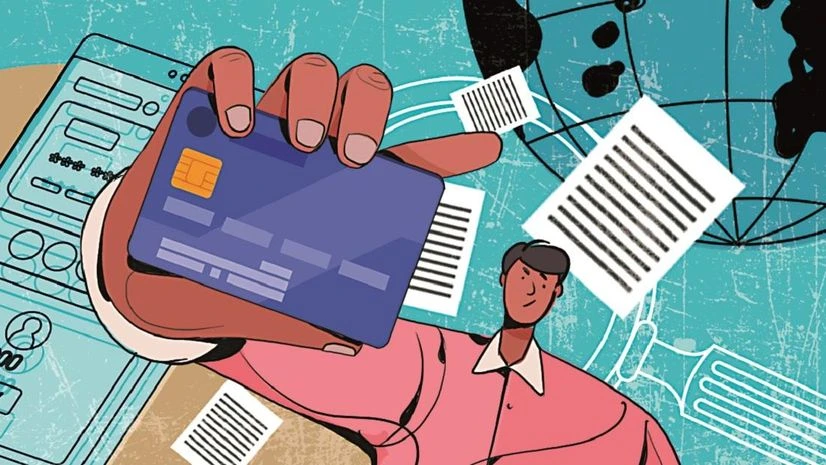)
Illustration: Ajay Mohanty
The increasing allure of Buy Now, Pay Later (BNPL) schemes and easy e-commerce instalment purchases is propelling young millennials into a credit card debt spiral. According to data from TransUnion Cibil, credit card defaults have risen from 1.6 per cent in March 2023 to 1.8 per cent by June 2024. Although this may seem marginal, the amount of outstanding credit card dues has skyrocketed to nearly Rs 2.7 trillion by June 2024, compared to Rs 2.6 trillion in March 2024 and just over Rs 2 trillion in March 2023, reported The Economic Times.
Pre-pandemic, in March 2019, total card outstanding stood at Rs 87,686 crore, reflecting a 24 per cent compound annual growth rate (CAGR) over five years.
Young borrowers maxing out credit limits
Research analyst Suresh Ganapathy from Macquarie notes that young millennials are maxing out their credit limits and turning into non-performing assets (NPA) without even revolving their loans.
Net credit losses in credit cards have reached as high as 5-6 per cent, with SBI Cards reporting a concerning 7.5 per cent net credit loss last quarter, he said.
“Much of this stems from a shift in consumer behaviour, with most payments on e-commerce platforms such as Amazon being made via credit cards. The rising trend of BNPL and EMI options has given consumers easy access to credit for purchases,” V Balasubramanian, CEO of Financial Software and Systems, told The Economic Times.
“This is typical of economies transitioning from savings-driven to consumption-driven. The younger generation now owns a bigger slice of credit card usage and spends heavily on e-commerce,” he added.
The default journey: How it begins
The growth of digital payment systems, reliable internet services, and the expanding reach of e-commerce has created a favourable environment for the credit card industry. However, the appeal of EMIs for large purchases often leads younger users to default. Many find themselves caught in a cycle of impulsive spending, accruing debt with interest rates that can soar as high as 48 per cent annually.
Ritesh Srivastava, founder and CEO of debt relief platform Freed, explained, “Borrowers begin their default journey by making large purchases, planning to repay in instalments, but soon find themselves only able to make minimum payments. To cover this, they take out small-ticket personal loans, leading to loan-stacking.”
According to Srivastava, credit scores fail to act as a deterrent, as borrowers maintain their minimum payments, preventing them from being classified as defaulters.
RBI steps in to curb the unsecured credit surge
Retail loans, which have driven Indian banking growth for two decades, are facing heightened scrutiny. With unsecured loans growing faster than corporate loans, the Reserve Bank of India (RBI) flagged risks in this segment last year, particularly loans under Rs 10,000 that banks were aggressively pushing.
The RBI’s intervention, which included increasing risk weights on unsecured consumer credit and bank loans to non-banking financial companies (NBFCs), has started showing results. Macquarie’s unsecured retail index reports a significant drop in credit growth to 15 per cent post-RBI measures in November 2023.
Additionally, personal loans saw a dramatic slowdown in growth from 36 per cent in June 2023 to just 3 per cent in June 2024, and credit card originations fell 30 per cent Y-o-Y, reflecting lenders’ cautious stance.
Push for secured credit cards amid credit tightening
With the credit card industry slowing down after years of rapid growth, there is now a renewed push towards secured credit cards — cards backed by term deposits. Previously reserved for professionals and those without fixed salaries, this product is now being aggressively marketed by both small and large lenders, including Axis Bank and HDFC Bank.
Non-metro borrowers more credit conscious
Interestingly, non-metro borrowers, particularly in rural, urban, and semi-urban areas, are becoming more credit-conscious than their metro counterparts. TransUnion Cibil reports a 57 per cent rise in consumers monitoring their credit in non-metro regions, compared to a 33 per cent increase in metro areas. Self-monitoring has led to a notable decrease in personal loan applications, with post-monitoring credit behaviour showing increased use of two-wheeler loans, consumer durable loans, and gold loans, but a 16 per cent drop in personal loans.
The number of Gen Z borrowers (born after 1996) tracking their credit scores has surged by 150 per cent in FY23-24, signalling a growing sense of credit discipline among the younger population.
With India’s credit card landscape shifting, the RBI’s intervention, combined with a push for secured credit products, may help stabilise the sector. However, the rise of BNPL schemes and impulsive e-commerce purchases continue to drive defaults, leaving young borrowers in precarious financial positions. While some are becoming more credit-conscious, the trend towards unsecured loans and easy credit options remains a cause for concern.
First Published: Sep 26 2024 | 5:31 PM IST


































